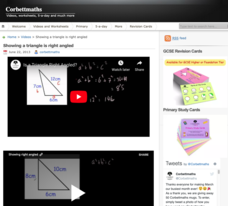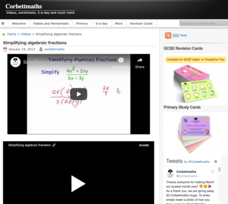Mathispower4u
Dividing Polynomials by Monomials
Split the polynomial into terms. The video shows how to divide a polynomial by a monomial. By splitting the polynomial into its terms, the problem then becomes dividing several monomials by a monomial. Class members become familiar with...
Corbett Maths
Transformations: Translations
Slide into vector transformations. Column vectors define the translation of figures by defining the number of units to move horizontally and vertically on the coordinate graph. Pupils develop an understanding of how to read the...
Corbett Maths
Rotations
Develop the basics of turns. A helpful video discusses the information required to perform a rotation. Afterward, the narrator shows pupils how to perform a rotation by using a piece of tracing paper to determine where the image will be...
Mathispower4u
Negative Exponent: Why Is a^(-1)=1/a?
Follow a pattern to develop an explanation. An engaging video uses the pattern of positive integer exponents to develop an explanation of the rule for negative powers. Using powers of three, each lower power is the previous one divided...
Corbett Maths
Hexagon Inscribed Within a Circle
Mark off the length of the radius around the circle. Using a compass, the presenter shows how to construct a regular hexagon in a circle. Pupils see how triangles formed in the hexagon are equilateral, allowing for the construction to...
Corbett Maths
Construct a 90 Degree Angle
There is more than one way to create a 90-degree angle. Using a compass and a straightedge, the video shows two ways to construct a right angle. The ways include using perpendicular bisectors and circle theorems. To wrap up, pupils...
Corbett Maths
Showing a Triangle Is Right Angled
Determine whether it is right or not. Using the Pythagorean Theorem, the video shows how to determine whether a triangle is a right triangle. Pupils practice the skill in a few of the problems in the associated worksheets on the...
Corbett Maths
Constructing Equilateral Triangles and 60 Degree Angles
Creating a 60-degree angle also creates an equilateral triangle. By watching the video, individuals learn the steps required to construct a 60-degree angle. The presentation shows that the process is the same for constructing an...
Corbett Maths
Dividing Algebraic Fractions
Do the keep, change, flip dance. The resource shows that the division of algebraic fractions follows the same rules as dividing numerical fractions. Pupils understand that if they can multiply rational expressions, they can divide...
Corbett Maths
Multiplying Algebraic Fractions
Make the complicated look relatively simple. The video shows how multiplication of algebraic fractions is easier when they factor the numerators and denominators. Pupils see which factors will cancel, or divide out, easier when writing...
Corbett Maths
Simplifying Algebraic Fractions
Simplification is about factoring. While working with rational expressions, pupils must know how to factor. The video shows how the process of finding common factors in algebraic fractions is similar to finding common factors in...
Corbett Maths
Adding Algebraic Fractions
The process requires the combination of several concepts. A video shows how individuals need several concepts to add rational expressions. Pupils must remember they need to find common denominators, combine like terms, and use the...
Corbett Maths
Dividing Algebraic Expressions
Get back to the basics to become an expert. The short video shows the basics of dividing algebraic expressions. Using several examples, the presenter reminds viewers of the rules of exponents when dividing. Pupils practice dividing...
Corbett Maths
Density
A short video introduces the triangle that illustrates how to find any value given the other two in the density formula. Class members use the triangle to work several problems to find the mass, volume, or density of an object.
Corbett Maths
Average Rate of Change
Simply find the slope to find the average rate of change. A short video provides the definition of the average rate of change. Using the definition, pupils calculate the average rate of change to solve problems that cover finding average...
Corbett Maths
Function Machines
It's not a time machine—it's a function machine! Using two rules, the video introduces a function machine that changes an input to an output. Pupils answer questions such as finding what is the input for a given output and what values...
Corbett Maths
Quadratic Inequalities
Develop a sketchy approach to solving quadratic inequalities! Using a sketch of a graph, the presenter shows a way to solve quadratic inequalities. Pupils then practice that method to solve their own quadratic inequalities and apply the...
Corbett Maths
Volume of a Pyramid
All you need is the formula. Given the formula, a short video show how to find the volume of a rectangular prism. The presenter explains the different variables of the formula and uses it to find an unknown height. Worksheets provide...
Corbett Maths
Volume of a Sphere
The volume of a snowball's chances in ... Using a snowball, the video introduces the formula for finding the volume of a sphere. The presenter then talks the class through the process of finding the volume after determining the length of...
Corbett Maths
Volume of a Cone
Is it possible to find the volume of a cone? Of course! Using the formula for the volume of a cone, the video shows how to calculate an exact and an approximate answer for a cone's volume. The worksheets challenge pupils to perform...
Corbett Maths
Volume of a Cylinder
Circle up the base. Using the formula for the volume of a cylinder, the presenter calculates the volume of a given cylinder. The video shows that the volume formula for a cylinder and the volume formula for a prism arrive at the same...
Corbett Maths
Volume of an L-Shape Prism
The formula works no matter the shape of the base. A short video shows how to find the volume of a prism when the base is a composite shape created by rectangles. Handouts provide the class members opportunities to practice the skill and...
Corbett Maths
Volume of a Prism
Not all prisms are cubes. A short video introduces the definition of a prism and uses that definition to create a general volume formula. Worksheets provide pupils several opportunities to practice finding the volume of a wide variety of...
Corbett Maths
Volume of Cuboids and Cubes
Turn up the volume. After identifying the three dimensions of a prism, the presenter gives the formula for finding its volume. Using the formula, the video shows pupils how to find the volume of a rectangular prism and a cube. Classmates...























